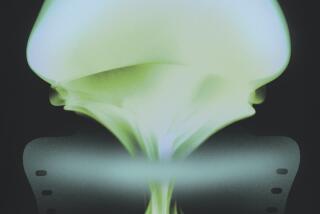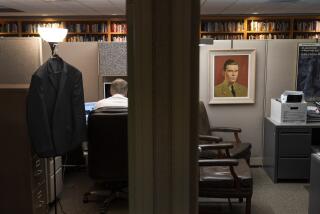Revelations Don’t Change the Facts . . .
- Share via
The fall of the Berlin Wall nine years ago generated a shock wave that still reverberates within American political culture. The collapse of European communism opened the gates to a vast river of once-secret intelligence files. From the archives of the CIA and even more so from the Kremlin, the documents have poured forth, revealing a hidden history of the Cold War and of the regimes that waged it.
Many of the most sensational revelations confirm the reality of Soviet efforts to influence or gain intelligence about events within the United States, especially during the crucial midcentury decades when American communism stood at its political apogee. Cables and gold did flow from the Kremlin to Communist Party officials and useful “fellow travelers.” CIA release of the once ultrasensitive “Venona” decryptions adds new weight to the evidence that Julius Rosenberg really did transmit A-bomb secrets to the Soviets, that Alger Hiss was part of a communist intelligence-gathering group within the New Deal and that Harry Dexter White, a high-level Treasury official, was considered a Soviet “asset.”
But these declassified cables and documents are about far more than a half-century-old cloak-and-dagger operation. At stake here is the legitimacy and moral standing not so much of the U.S. communist cadre, who have precious few defenders anymore, but of a multistranded tradition of American radicalism that takes its spirit as much from Walt Whitman and Henry Thoreau as it does from W.E.B. DuBois, Eugene Debs, Betty Friedan and Noam Chomsky. Right-wing, post-Cold War triumphalists seek to “red bait” not only their historic enemies but also contemporary radicals and reformers. “There is no ‘after the Cold War’ for me,” writes the neoconservative Irving Kristol. “So far from having ended, my cold war has increased in intensity as sector after sector of American life has been ruthlessly corrupted by the liberal ethos.”
Thus American conservatives have had a field day exploiting these revelations. Joseph McCarthy, whose name has long been synonymous with “witch hunt,” seems on the verge of rehabilitation by the right. “His concentration on security loyalty practices was absolutely correct,” says William F. Buckley, who defended the Wisconsin senator in the 1950s. And George Will has gleefully endorsed the Yale University Press series, “Annals of Communism,” that is translating and publishing documents linking American liberals and communists to the Soviet intelligence apparatus. To Will, these volumes demonstrate that “the left was on the losing side of history and deserved to be.” Right-wing foundations, including the Olin, Smith-Richardson and Bradley, not otherwise known for their support to Ivy League publishing ventures, have contributed handsomely to the Yale series.
When conservatives speak of the left today, they don’t mean just communists or even radicals in general, but the entire effort to ameliorate inequality, reform capitalism and tame the market. “The catastrophe of the Soviet system has ended for all but the most obdurate the idea that a social plan can replace the market,” writes David Horowitz in his new book, “The Politics of Bad Faith.” “The totalitarian state was not an aberration of the progressive spirit but its consummation.”
But this mendacious effort to link the ideas and movements of the entire American left to a treasonous Stalinism collapses of its own contradictions. Contemporary right-wingers actually find themselves in a strange agreement with the old communists when it comes to an elaboration of the party’s vast influence during the 1930s and 1940s. Communist claims to left-wing hegemony are taken at face value. But written out of this right-wing history is an increasingly spirited and powerful anti-Stalinist impulse that battled the communists on their own left-wing turf. Late in the 1930s, New York intellectuals influenced by a Trotskyist critique of the Soviets generated a sharply honed set of ideological weapons, including a theory of the Soviet “New Class,” which would later prove so effective when postwar intellectuals like Reinhold Neibuhr and Arthur Schlesinger Jr. used them to draw a sharp distinction between the main body of American liberalism and the spurious reformism of those within the communist orbit.
And as for communist manipulation of the Republican cause during the Spanish Civil War, a radical, anti-communist perspective has always been highly influential. It began with George Orwell’s “Homage to Catalonia” and its moral weight is hardly less significant in Ken Loach’s 1995 film, “Land and Freedom.”
Meanwhile, the most important political battles determining the fate of American communism were taking place within the left-leaning half of the labor movement. Years before McCarthy became a national figure in 1950, labor liberals like Walter Reuther of the United Auto Workers and CIO President Philip Murray had inaugurated a campaign to eliminate communist influence within the great industrial unions of that era. They were encouraged to do so by the Truman administration and aided by conservatives in Congress and in management.
But as their communist opponents pointed out time and again, this purge could not have succeeded without the leadership of such key figures, who mobilized thousands of anti-communist unionists within the labor movement. Then and now, this institution clearly stood on the progressive, “collectivist” side of American politics and culture.
Moreover, the communists themselves were hardly a monolithic enterprise. The inner core of the party was a Stalinist bloc that took its line from Moscow, but the men and women who put these politics into effect were not automatons, which is why the party rank and file was in a constant state of flux. Sometimes they voted with their feet against a switch in the Soviet foreign policy line, but more often the ebb and flow of party strength came as a function of an autonomous shift in the nation’s political culture. Thus if one is interested in understanding the real impact of the party on American life, the cable traffic out of Moscow is far less useful than a study of social mobility on the Lower East Side of New York or the fate of the party at Ford’s multiethnic River Rouge complex.
And finally, contemporary American conservatives seem willfully ignorant about the real “threat” posed by the communists in the 1940s. Soviet influence and espionage was a problem largely because the emergence of a mass communist movement in the United States seemed possible. And that stood a chance only insofar as the postwar stability of American capitalism remained in question. But by the time McCarthy emerged on the scene, the New Deal and the warfare state had juiced the economy and slashed the already limited influence of the reds, which is one reason that most historians have been properly hostile to the entire McCarthyite project. The release of still more files from the Soviets and the CIA may prove titillating, but it is unlikely to change that judgment.
More to Read
Sign up for Essential California
The most important California stories and recommendations in your inbox every morning.
You may occasionally receive promotional content from the Los Angeles Times.










